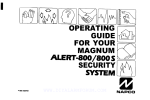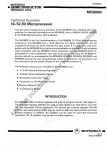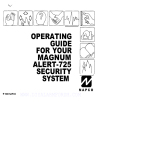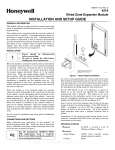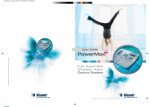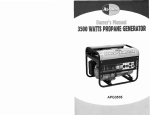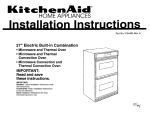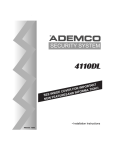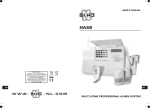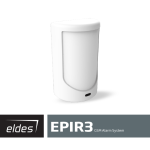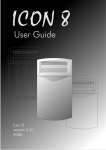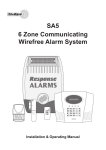Download 825 User Manual - Alarm Products Of Oklahoma
Transcript
OPERATING GUIDE FOR YOUR MAGNUM ALERT-825/ MAGNUM ALERT-825HS SECURITY SYSTEM 0 1880, NAPCO WWW.DIYALARMFORUM.COM N A P C O Please read this guide thoroughly to familiarize yourself with your new security system. Keep this booklet handy for future reference. Note especially the ALARM PLAN on page 15. Your alarm specialist will help you fill it out and explain the various features and operating procedures for your new Magnum Alert-825/825HS. NOTICE You’ll probably find items mentioned in this booklet which do not apply to your system. DON’T WORRY! The Napco Magnum Alert-8254 825HS has such a wide variety of features that few, if any, security systems will ever need them all. Your alarm professional has chosen appropriate features for your situation. Ask him about them. Your Magnum Alert-825/825HS is carefully designed and engineered to the highest industry standards. To provide optimum safety and security with this equipment, we recommend that the user become thoroughly familiar with the unit and periodically check its condition and state of readiness. Mini-Sounder ’ I Shunt Panic The face of the keypad lifts up to reveal a convenient index of protected zones. WWW.DIYALARMFORUM.COM Dlgltal Communicator Abort Delay A delay period that allows the system to be reset before it reports to a central station. Alarm Plan ldentifies the areas of your premises protected by each zone of protection and lists zone features. (See page 15) Ambush Code Reports burglary and emergencies directly to the central station over telephone lines. Napco’s Digit-key keypad puts Control Center functions at your fingertips. It can be mounted either at the Control Center or anywhere in your premises. Exlt/Entry Delay A one or two-digit code used before an arm/ disarm code that causes a silent report to be sent to a central station. (Optional) Lets you exit and enter your premises without setting off an alarm after the system is armed. Arming/Disarming Digit keys have secondary functions which are activated by holding down a digit until a beep is heard. Turning your system ON or OFF. This can be done by entering a code on the DigitKey keypad, or by turning an optional keySwitch. Arm/Dlsarm (Personal) Codes Up to 4 four-digit codes used to arm and disarm the system from the keypad. Battery Hold Down Functlon Fallback Code A pre-programmed four-digit code that may be used to disarm your system should all user codes be erased (as after an extended power failure). Mlnl-Sounder Central Station Buzzer at each Napco Digit-Key keypad warns that entry delay time has started. It also sounds when you attempt to arm the system if a particular zone is in “trouble”. It also verifies contact with a central station when a closing signal is sent (optional). Monitors incoming burglary and emergency messages from the Digital Communicator, and alerts the proper authorities. (Optional feature) Two buttons (* and #) on the Digit-Key keypad which will alert the central station of an emergency. Stand by battery Is placed in the Control Center box to provide backup protection in the event of a power loss. Control Center Panic Buttons the security system (alarm, trouble, low battery, etc.). (optional) Shunt Button Labelled "S" on the Digit-Key keypad. Lets you manually remove one or more protective zones from the system. Report WWW.DIYALARMFORUM.COM The heart of the Magnum Alert-825 security system: it controls all system functions. A communication sent to a central station indicating a specificchange in condition of Zones Independent, circuits that protect specific areas of your premises. Auto Shunted Zone: A zone capable of being automatically bypassed (shunted) out of the protection system if it is in “trouble” (faulty) when you attempt to arm the system. Burglary Zones: Detect intrusion. Day Zone: A zone programmed to cause visual and audible ( optional) indication at the Digit-Key keypad when it is in ”trouble” during the disarmed period. Exlt/Entry Follower Zone: Provides exit and entry delay for interior devices. Entry delay only occurs if re-entry takes place through the normal exit/entry door. Group Shunt Zones: A group of zones programmed so they can be manually by passed (shunted) all at once. Priority Zones: When a zone selected for the feature is in “trouble” it will be impossible to arm the Control Center. Selectlve Shunted Zones: Zones that can be individually bypassed (shunted) using the Shunt Button. Trouble Zones: Zones that cannot be armed becauseof an open window, door or other problem in the area. 24 Hour Zone: Are always armed and ready at all times to respond to an emergency situation. 3 lndicator Lights Mint-Sounder ARMED/MEMORY (Red) l Steady- system is armed. l Flashes - alarm condition. Flashes indicate the number of zone(s) which were violated. (see page 5, Key 2) l STATUS (Green) Steady - system is disarmed, all zones okay. l Flashes - a non-24 hour zone is in trouble. Flashes indicate the number of the zone(s) that are in trouble. Note: to stop flashing hold down Key 3 for two seconds, l SHUNT (Yellow) ,o Steady - one or more zones manually shunted (bypassed). NOTE: all three lights flashing together indicates that AC power has been lost. Reset indication with Key 9 (see page 5). Steady Tone: day zone in trouble; entry delay in progress; system armed with a priority zone in trouble. l Beep (2 seconds): system armed with any zone auto shunted; or battery power low. Arm-Disarm/Run/Load Switch l Used to load (program-in) user arm/disarm codes. Slide switch to the right (LOAD) position when entering codes (refer to Selecting Your Codes on page 7). Be sure to return theswitch to the center (RUN) position after all codes have been entered. Setting this spring-return switch to the left will also arm or disarm the system (unless this option has been removed). Your system will not operate with the switch in the LOAD position. WWW.DIYALARMFORUM.COM Keys NOTICE:Keys1,2,3,4,5,9 and S must be held down for 2 seconds (until mini-sounder beeps) to perform their desianated ‘Hold- Down " (“Key”) functions. Key 1: TEST Momentarily sounds the burglar alarm from the battery. If no alarm is heard, or if it is weak, the battery may need replacing. Use this test weekly. (To perform this function the key must be held down until a beep is heard.) Key 2: ALARM HISTORY This will flash the red ARMED/ MEMORY light to indicate the last alarm condition. Count the number of flashes to determine the zones violated. This feature does not reset; after the system is rearmed, the previous alarm history will remain in alarm memory until automatically reset by a new alarm condition. To perform this function the key must be held down until a beep is heard, and then continued to be held down until all information has been displayed. Key 3: STATUS INDICATION RESET This will stop the green STATUS light flashing. To turn STATUS flashirig back on, hold down Key 3 aaain. (To oerform this function the key must be held down until a beep is heard.) Key 4: INSTANT PROTECTION Cancels the exit/entry delay periods when arming. The delay is restored after you disarm the system. See page 10. (To perform this function the key must be held down until a beep is heard.) Key 5: DOOR CHIME This will initiate a feature that sounds a chime In the keypad each time the entry door on zone 1 is opened. This feature only works when the alarm system is disarmed (off). To eliminate the door chime feature, press this key again. A lengthy “chime” may be reset using Key 9 (MA-825HS only). (To perform these functions, the key must be held down until a beep is heard.) Key 9: RESET Used to reset a Dav Zone MiniSounder indication (MA-825HS only), a lengthy door “chime” (MA-825HS only). or the AC Failure indication (all three indicatora flashing), and to ’ bypass a troubled zone deaignated as a “Priority with Bypass Zone.” (To reset any function, the key must be held down until a beep is heard.) Key S: SHUNT This will flash the vellow SHUNT light to indicate the zone(s) shunted. Count the number of flashes to determine the zone(s) shunted. To perform this function the key must be held down until a beep is heard, and continued to be held down until all information has been displayed. The key does not have to be held down for either the Selective Zone Shunting feature (see page 10) or when selecting a new code (see page 7). Keys * and #: PANIC BUTTONS Activates the panic zone. Refer to “Panic Zone”, page 10 for more information. WWW.DIYALARMFORUM.COM Your Magnum Alert-825/825HS Security System has three basic components: 1. Zones 2. The Dlglt-Key Keypad 3. The Alarm Output Your system is capable of monitoring up to six separate areas of your premises, including Ambush/Panic and Auxiliary zones. Each zone is an independent circuit that protects a specific area of your premises. For example: your alarm specialist may have set aside a zone for window protection, exit/ entry delay, interior space protection, safe and valuables protection or emergencies. Each zone can be “programmed’ to react in aspecific manner. Check and be certain that you know what each zone protects. Lets you program arm/disarm codes; arm and disarm the system; check the condition(status) of each zone; temporarily bypass (shunt) individual (or group of) zones; send an ambush alarm; cancel exit/entry delay; test the battery and alarm devices; reset the AC-failure indication; and bypass a Priority-withBypass Zone. Three lights and a Mini-Sounder on the Digit-Key keypad monitor the system. When any zone is activated, the Control Center responds by sounding an audible alarm and/or alerting a central station (optional). Your alarm specialist has programmed your system to react in a specific manner to each type of emergency. Be sure you understand how your system responds to these emergencies. WWW.DIYALARMFORUM.COM The Digit-Key Keypad Selecting Your Codes All security system operations are carried out at the keypad. Each key hasaspecialfunction of its own (see “CONTROLS” page 5) plus the ability to arm and disarm the system when they are used in a preselected combination (codes). To program these codes, slide the ARM-DISARM/RUN/LOAD switch (upper left corner of the Control Center, see page 4) to the right (LOAD). The three lights on the keypad will flash rapidly, and the Mini-Sounder will beep. At the keypad, enter any combination of up to four digits (there is no zero) as follows: Press: l S + 1 + Four digit First User’s Personal Code S + 2 + Four digit Second User’s Personal Code l S +3 + Four digit Third User’s Personal Code l S + 4 + Four digit Fourth User’s Personal Code After all user codes have been entered, return the ARM-DISARM/ RUN/LOAD switch at the Control Center to the center( RUN) position. Remember: your system will not operate with the switch in the LOAD position. NOTE: You need not assign all four codes. Use only as many as you Personal ( Arm/Disarm) Codes You can choose up to4 four-digit codes which will allow you to arm and disarm your system. Any of these codes can easily be changed, thus allowing temporary guests, babysitters, employees, etc., access to the premises. When no longer needed, the codes can be changed or removed from service. Your security system cannot be disarmed by unauthorized persons. It will respond only when a code of your choosing is entered through the keypad. need, and change them as often as you feel necessary (refer to Changing or Voiding a Code). Easy Arming (MA-825HS only) If programmed, this feature permits quick arming by momentarily pressing Key 8. Disarming, however, will still require entry of a complete code. Changing or Voldlng a Code Changing any user’s code is accomplished by using the foregoing procedure and simply changing the 4-digit combination. Thus. to change User 3’s code: 1. Set the ARM-DISARM/RUN/ LOAD switch to LOAD. 2. Press S + 3 + Four new digits, user 3’s new code. 3. Return the ARM-DISARM/ RUN/LOAD switch to RUN. WWW.DIYALARMFORUM.COM 7 Checking AC Power If the three lights of your keypad are blinking slowly, you have lost AC power. Check to see if there has been a general power outage, or if the Control Center’s transformer is disconnected. If you must operate without AC power, press Key9 to stop the lights from blinking. Next, test your standby battery by pressing Key 1. If the alarm doesn’t sound, or is weak, replace the battery. Check your battery weekly. Armlng The System Before You Leave 8 Before you attempt to arm the system, check the STATUS light on the keypad. If the light is on, you may enter your code, but be prepared to leave immediately. Upon arming, the red ARMED/ MEMORY light will come on and the green STATUS light will go out. Leave immediatelythrough the exit/ entry door before the exit-delay time runs out. If you take too long to leave the premises, the Mini- Sounder will warn you that exitdelay time has expired and entrydelay time has started. To avoid causing an alarm, quickly return to the keypad and enter your code to disarm the Control Center. You may then rearm and try to exit again. System Does Not Respond to Personal Code If after an extended power failure your personal codes do not work, you can temporarily use the " Fallback” code to operate the system. To restore personal codes, see page 7 “Selecting Your Codes”. Arming With A Zone In Trouble If the green STATUS light is flashing, at least one’non-24 Hour Zone is in trouble (in an open or shorted condition) and incapable of being armed. Count the number of flashes to determine the zone(s) in trouble. For example, if your back door is open on Zone 1 and a window is open on Zone 3, the STATUS lamp will flash once for Zone 1; pause; then flash three times for Zone 3. Try to clear the troubled zone(s) yourself. In this example you can clear the zones by merely closing the back door and the window. If the zone cannot be fixed (green light still flashing), it may still be possible to arm the system without the protection of that zone. Check your Alarm Plan (see page 15). If the zone in trouble is not designated as a Priority Zone, you will be able to arm your system anyway. A 2second beep at the keypad MiniSounder will alert you that the system was armed with a zone automatically bypassed (auto-shunted) and no alarm will occur. Be sure to have all zones in trouble repaired as soon as possible! If you cannot clear the zone yourself, call your alarm specialist. You cannot arm your system if a zone programmed as a Priority Zone is in trouble. The Mini-Sounder will come on, but the ARMED/MEMORY light will not. To silence the sounder, re-enter your code to disarm. WWW.DIYALARMFORUM.COM If trouble is encountered on a zone programmed as a Prioritywith-Bypass Zone however, enter your code to silence the MiniSounder and disarm; hold down Reset Key 9 until it beeps (this will bypass the alarm condition); then enter your code to rearm. Disarming When You Return When you enter through the exit/ entry door, the Mini-Sounder will come on during the entry period to remind you to disarm. Check the red ARMED/MEMORY light; if it is flashing, an alarm occurred while you were out. Using your code, disarm the system immediately during the entry period to prevent an alarm and to silence the MiniSounder. NOTE: If you enter the wrong code, you must wait at least 2 seconds before re-entering. If there was an extended power failure and your system does not respond to your correct code, enter your preprogrammed “Fallback” code to disarm. See page 8. To identify which zone(s) were violated, hold down Alarm History Key 2 until it beeps. The red ARMED/ MEMORY light will flash to indicate the last alarm condition. Count the number of flashes to determine which zone(s) require attention. NOTE: If an alarm occurredand the red light did not flash, a 24 Hour Zone (see your Alarm Plan) was violated. The cause of the alarm must be determined and cleared before you can rearm your Control Center. Ambush Code (optlonal) If an intruder forces you to disarm your system, enter your preprogrammed 1- or P-digit Ambush Code before your disarm code. This activates your Ambush Zone, which is usually programmed to send a silent alarm to a central station (optional feature). If your system is monitored by a central station, be sure to memorize your ambush code. WWW.DIYALARMFORUM.COM 9 Arming Wlth Selective Zone Shunting Your alarm specialist may have opted for one or more zones that can be selectively shunted (removed) from the system. Since a shunted zone cannot cause an alarm, you may wish to use this feature to turn OFF the interior areas while arming, and keeping your perimeter zones (windows, doors, etc.) active. To arm, check the green light to make sure no zone is in trouble. Press the shunt button ( labeled "S”), and then the number of the zone (1 through 6) you wish to shunt Your alarm specialist may also have opted for interior zones to all be “group shunt” zone-s Shunt these zones simply by pressing the "S" key twice. The yellow shunt light will come ON whenever you shunt one or more zones. Enter your arm/ 10 disarm code to arm your remaining zones. The green light will go OFF, and the red ARMED/MEMORY light will come ON. The yellow light will go OFF when you disarm again indicating that the shunted zones are no longer shunted.( Note: The shunt light does NOT come on when zones are auto-shunted.) Arming With Instant Protectlon Panic Zone To activate the panic zone, simultaneously press the two keys marked * and # on the Digit-Key keypad. The panic zone can be programmed to send a silent alarm to a central station. activate an audible alarm, or both. I’ Pressing key 4 (until you hear a beep) will cancel the exit/entry delay on the exit/entry zone when arming. The red ARMED/MEMORY light will flash rapidly to indicate this condition. If someone enters through the exit/entry zone, an alarm will sound immediately. WWW.DIYALARMFORUM.COM Your Alarm Specialist may have programmed your security system to be monitored by a central station. The built-in digital communicator can transmit emergency signals to the central station 24 hours a day. EMERGENCY SERVICES MONITORS YOUR SYSTEM 24 HOURS (Police, Medical Etc) PR PREMISES ALERT-825/825HS COMMUNICATOR WWW.DIYALARMFORUM.COM 11 Abort Delay Note which zones on your alarm plan have abort delay. This is a delay that enables you to reset the system before a zone condition report is sent to the central station. Non-24 hour zone reports are aborted by arming and then disarming. 24 hour zones, however, must first be repaired. 12 Opening and Closing Reporting An optional feature that permits the central station to receive a signal each time the system is armed, disarmed or both (up to 4 individual users can be identified). Central Station Rlngback The central station will acknowledge the fact that you have armed your system by “ringing back” with a short beep from the Mini-Sounder. (This is an optional feature that responds to closing reports only.) WWW.DIYALARMFORUM.COM The following information is applicable only where local ordinance permits use of your alarm Control Center for fire detection Controlling Your Fire Circuit If your alarm specialist installed smoke detectors or heat sensing thermostats, you have 24 hour fire protection. This optional Fire Protection Zone is always active, even though your system may be disarmed. An optional Fire Supervision and Indicator Station on the Control Center provides the following fire circuit controls. AC Power Check If the yellow AC light on the Fire Supervision and Indicator Station is off, the Control Center is not receiving AC power. Press the springloaded SILENCE & FIRE RESET switch to shut off the Mini-Sounder. Check lights to see if there is a general power outage. If there is, you will be operating from your standby battery. When AC power is restored. the Mini-Sounder will come back on. Press the springloaded switch again to silence the Mini-Sounder. Fire-Zone Check The Mini-Sounder on the Fire Supervision and Indicator Station signals a problem on the Fire Zone. Press the spring-loaded SILENCE 8 FIRE RESET switch to shut off the Mini-Sounder. The red TROUBLE light will come on until the Fire Zone is cleared. When the zone is restored, the Mini-Sounder will signal again to indicate that the Fire Zone is functional. Press the SILENCE & FIRE RESET switch once again to turn off the MiniSounder. Fire-Detector Reset After a fire alarm, the red FIRE ALARM light will be on. Press the SILENCE & FIRE RESET switch to clear the smoke detectors. Alarm/Battery Test The fire alarm bell/siren and standby battery should be tested weekly. Disarm the Control Center. Push the BATTERY & BELL TEST switch down and listen to the bell/ siren. If the alarm sounds weak, the battery is faulty. Call for service. Would You Like More Safety Informatlon? For information on home fire detection, burn safety, and home fire safety, contact the National Fire Protection Association, Public Affairs Dept.05A, Battetymarch Plaza, Quincy, MA 02269. NOTE: If there is no Fire Supervision and Indicator Station on your Control Center and your Fire Zone uses smoke detectors, have your alarm specialist show you and explain the switch he has installed for resetting the smoke detectors after an alarm. WWW.DIYALARMFORUM.COM 13 Even with the most advanced fire alarm system, adequate protection requires an escape plan. To prepare your plan: Draw floorplans of your building. Show two exits - a front or back door and a window from each room. (Make sure the window works. You may need a special fire escape ladder if the window is high up.) Write down your outside meeting place. Family Rehearsal Rehearse each of the following activities: 1) Everyone in their room with the doors closed. 2) One person sound the alarm. 3) Each person tests his door. 4) Pretend the door is hot and use the alternate escape exit. 5) Everyone meet outdoors at the assigned spot. 14 IMPORTANT - Read Carefully Discuss these escape procedures with those who use the building. 1) In a residence, sleep with the bedroom doorclosed. A closed door will hold back deadly smoke while you escape. 2) When thefirealarm signals, escape quickly. Do not stop to pack 3) Test the door. If it is hot, use your alternate route through the window. If the door is cool, brace your shoulder against it and open it cautiously. Be ready to slam the door if smoke or heat rush in. Crawl through smoke, holding your breath. Close the doors again on leaving to helppreventthefirefromspreading 4) Go to your specific outdoor meeting place so you can see that everyone is safe. 5) Assign someone to make sure nobody returns to the burning building. 6) Call the fire department from a neighbor’s telephone. WWW.DIYALARMFORUM.COM Zone Area Protected Zone Features Contacts (doom, wlndows, etc.) 1 6 Central Station (Optional) Service Person Telephone Telephone WWW.DIYALARMFORUM.COM 15
















